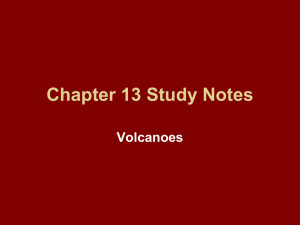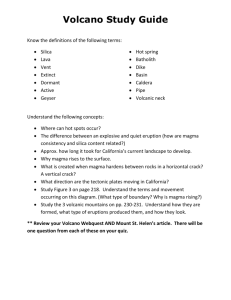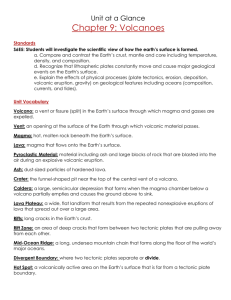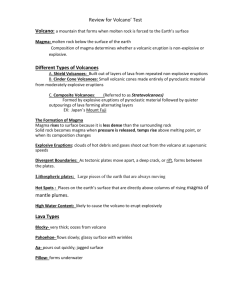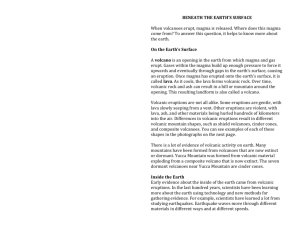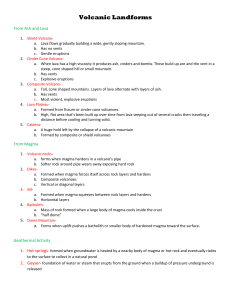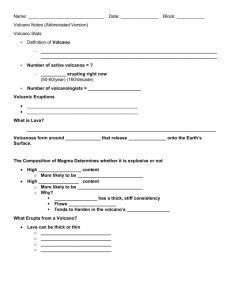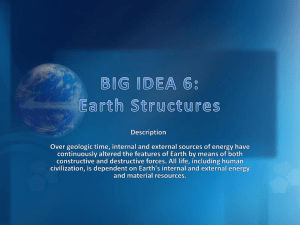File - RHS Earth Systems
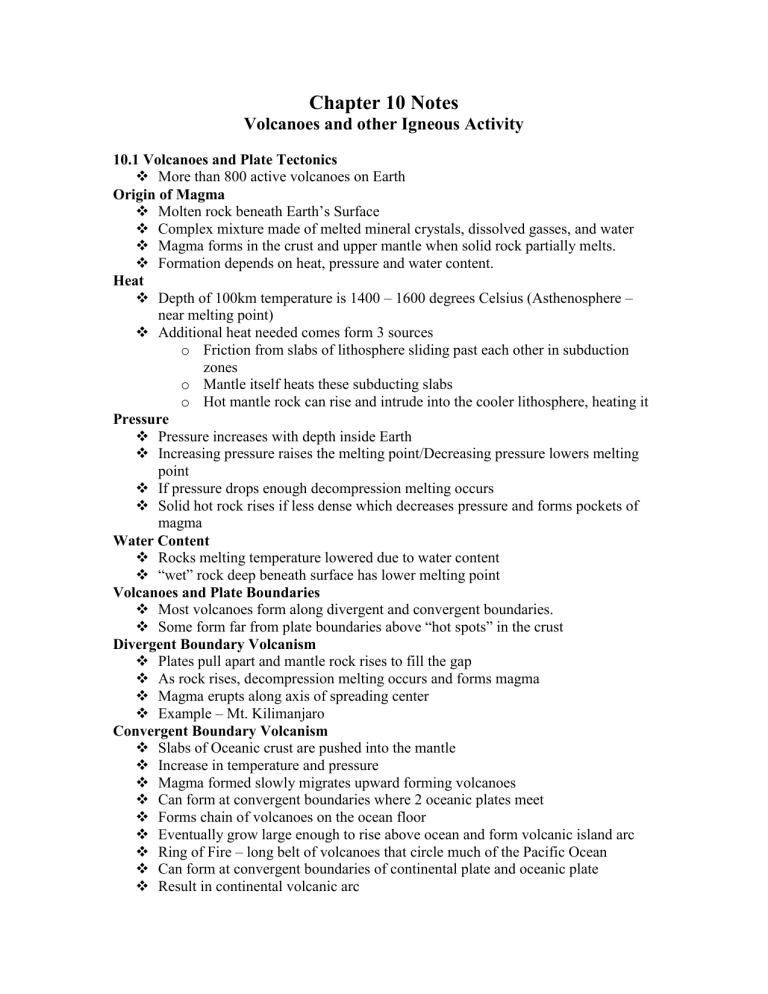
Chapter 10 Notes
Volcanoes and other Igneous Activity
10.1 Volcanoes and Plate Tectonics
More than 800 active volcanoes on Earth
Origin of Magma
Molten rock beneath Earth’s Surface
Complex mixture made of melted mineral crystals, dissolved gasses, and water
Magma forms in the crust and upper mantle when solid rock partially melts.
Formation depends on heat, pressure and water content.
Heat
Depth of 100km temperature is 1400 – 1600 degrees Celsius (Asthenosphere – near melting point)
Additional heat needed comes form 3 sources o Friction from slabs of lithosphere sliding past each other in subduction zones o Mantle itself heats these subducting slabs o Hot mantle rock can rise and intrude into the cooler lithosphere, heating it
Pressure
Pressure increases with depth inside Earth
Increasing pressure raises the melting point/Decreasing pressure lowers melting point
If pressure drops enough decompression melting occurs
Solid hot rock rises if less dense which decreases pressure and forms pockets of magma
Water Content
Rocks melting temperature lowered due to water content
“wet” rock deep beneath surface has lower melting point
Volcanoes and Plate Boundaries
Most volcanoes form along divergent and convergent boundaries.
Some form far from plate boundaries above “hot spots” in the crust
Divergent Boundary Volcanism
Plates pull apart and mantle rock rises to fill the gap
As rock rises, decompression melting occurs and forms magma
Magma erupts along axis of spreading center
Example – Mt. Kilimanjaro
Convergent Boundary Volcanism
Slabs of Oceanic crust are pushed into the mantle
Increase in temperature and pressure
Magma formed slowly migrates upward forming volcanoes
Can form at convergent boundaries where 2 oceanic plates meet
Forms chain of volcanoes on the ocean floor
Eventually grow large enough to rise above ocean and form volcanic island arc
Ring of Fire – long belt of volcanoes that circle much of the Pacific Ocean
Can form at convergent boundaries of continental plate and oceanic plate
Result in continental volcanic arc
Intraplate Volcanism.
Kilauea volcano in Hawaii is Earth’s most active volcano
Yellowstone National park is a volcanic region
Interaplate volcanism – volcanic activity that occurs within a plate
Occurs where a mass of hotter than normal mantle material called mantle plume rises toward the surface
Hot spot – small volcanic region a few hundred km across
More than 40 hot spots are known
Volcanic mountains of Hawaii have formed as the Pacific Plate moves over a hot spot.
10.2 The Nature of Volcanic Eruptions
Factors Affecting Eruptions
Primary factors that determine whether a volcano erupts explosively or quietly include characteristics of the magma and the amount of dissolved gases in the magma
Magma that has reached the surface is called lava
Lava cools and hardens to form rock
Viscosity
Substances resistance to flow
Temperature and chemical composition determine viscosity
Chemical composition has effect of type of eruption.
More silica in magma the greater its viscosity
More viscous = explosive eruption
Dissolved Gases
Gases trapped in magma provide force to propel molten rock out of vent
Vent – an opening to the surface
Gases are mostly water vapor and carbon dioxide
Reduced pressure allows dissolved gases to be released suddenly
Volcanic Material
Explosive eruptions eject lava as well as broken rock, lava bombs, fine ash and dust
Eruptions also emit large amounts of gases
Lava Flows
Silica content and temperature affect lava flow
Pahoehoe – hotter faster moving basaltic lava
Aa – Cooler slower moving basaltic lava
Gases
Magma contains varied amount of gases
As pressure is reduced the gases begin to escape
Pyroclastic Materials
Particles produced in volcanic eruptions
2 -64 mm called lapilli or cinders
Larger than 64 mm called blocks when hardened lava or bombs when ejected as glowing lava
Types of Volcanoes
3 main types
Anatomy of a Volcano
Volcano begins when fissure develops in the crust
Magma is forced toward the surface
Magma collects in a pocket beneath the surface called a magma chamber
Gas rich magma rises form the chamber through a circular pipe
Reaches surface at a vent
Repeated eruptions eventually build a mountain called a volcano
Crater is at the summit of a volcano, deep walled depression
Form of volcano depends on composition of magma
Shield Volcano
Produced by the accumulation of fluid basaltic lavas
Most have grown from the deep ocean floor to form islands
EX – Hawaiian Islands and Iceland
Cinder Cones
Formed by ejected lava fragments that harden in the air
Fragments range form fine ash to bombs but most are lapilli or cinders
Usually product of a single eruption
Composite Cones
Most beautiful and potentially dangerous
Also called stratovolcanoes
Large, nearly symmetrical volcanic mountain composed of layers of both lava and pyroclastic deposits
Gas – rich magma
Most explosive eruptions
Most located in the Ring of Fire
Other Volcanic Landforms
Volcanic mountains are not the only landforms that result form volcanic activity
Calderas
Depression in a volcanic mountain after end of activity
Ex – Crater Lake
Volcanic Necks
Landform made of magma that hardened in a volcano’s pipe and later was exposed by erosion
Lava Plateaus
Volcanic landform produced by repeated eruptions of very fluid, basaltic lava
Erupts through long cracks called fissures
Lava spreads out over a wide area
Volcanic Hazards
Volcanic soil is good for farming
Hazards include lava flows, volcanic ash, pyroclastic flows, and mudflows
Mudflows called lahars occurs when water soaked volcanic rock and ash slide rapidly down hill.
10.3 Intrusive Igneous Activity
Most magma cools and hardens within the earth
Classifying Plutons
Structures that result form the cooling and hardening of magma beneath Earth’s surface
Types of Plutons – sills, laccoliths and dikes ( classified by size, shape and relationship to surrounding rock)
Sills and Laccoliths
Magma intrudes between rock layers close to the surface
Sill – magma flows between parallel layers of sedimentary rock
Laccolith – lens shaped pluton that has pushed the overlying rock layers upward
Dikes
Magma moves into fractures that cut across rock layers
Batholith
Largest bodies of intrusive rocks
Surface exposure of more than 100sq. km
Much larger than a pluton
Formed by plutons that clump together as they rise
Core of many mountain ranges
Ex – Sierra Nevada
